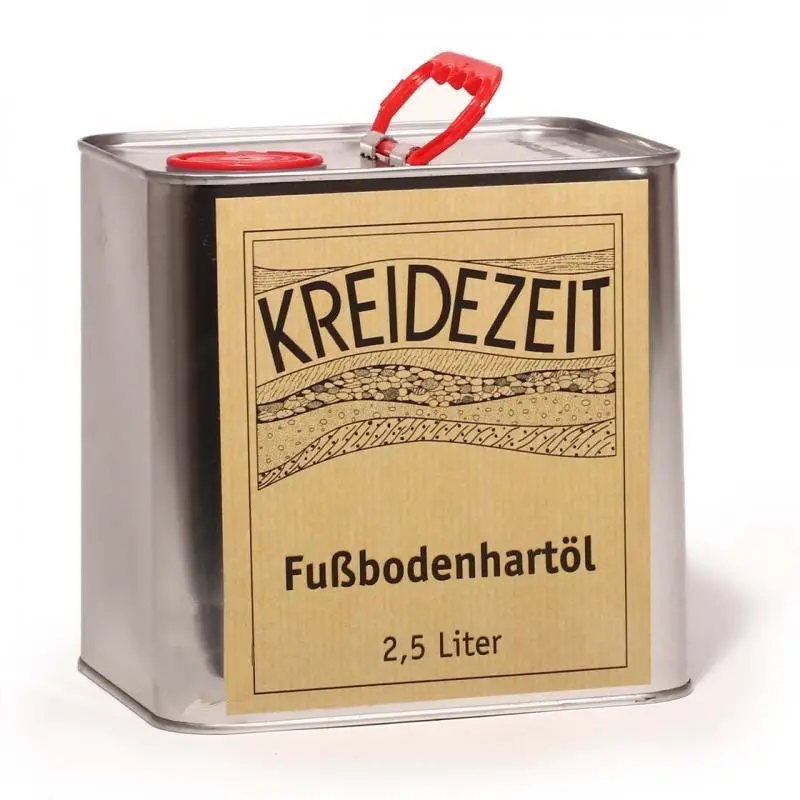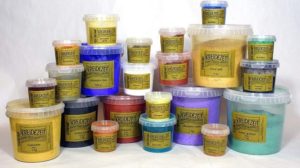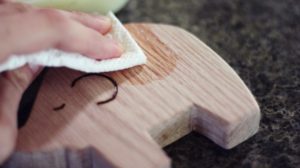It is about Kreidezeit's resistant floor oil. The oil is for indoors, natural, like all Kreidezeit products. It gives the treated surface resistance to intensive traffic. It can be used for treating wooden floors, cork, ceramic or natural stone.
Why this oil is so resilient
In the composition of the hard floor oil we find linseed oil, resistant wood oil, turpentine oil, calcium rosin, glycerol ester rosin. The presence of linseed oil helps the mixture to penetrate deep into wood or other porous materials (stone, cork). This is possible because linseed oil has a smaller molecule than other oils. The mixture penetrates deep into the wood and binds to the wood fiber, strengthening it.

How to work
The undiluted oil is applied directly to the untreated wood in two coats, possibly followed by a Carnauba wax or Carnauba wax treatment. Hard floor wax. The application can be done with a brush, paintbrush, paint brush, brush or cloth. To penetrate the wood, repeated strokes in a circular motion or along the grain are necessary.
After application, allow time for the material to absorb into the wood. After 30-45 min. the excess oil on the surface is wiped off with a dry cloth before drying.
Preparing the support. Untreated wood is cleaned, sanded with sandpaper 120-150, the edges are rounded and dusted. Remove resin pockets with alcohol.
Oil application. On highly absorbent surfaces (softwood, cork, tiles burned at lower temperatures) apply evenly and in excess of the resistant floor oil. Leave for approx. 30-45 minutes, after which the excess is removed with a dry, undampened cloth until the surface has a uniform sheen and a silky appearance. Removal is necessary because excess oil oxidizes due to air and becomes sticky.
On substrates with a lower absorption capacity (hardwood) the resistant floor oil should be diluted 20% with turpentine oil conditioner.
After the first layer of oil has dried - 24 hours at 20ºC - the sanding between layers with 220-280 grit sandpaper, sand and apply the next coat under the same conditions as the first. This is in fact the final coat. On hardwood it is better to apply a single coat of oil and finally a coat of hard floor wax.
Oil consumption is between 65 and 100 ml/m²/layer.
It is very important that the resistant floor oil does not form a film but penetrates deep into the wood. For increased wear resistance, a thin coat of hard floor wax or Carnauba wax emulsion is recommended.
How to maintain surfaces. Storage and cleaning of used materials
If waxed or oiled floors are not too dirty, rinse with warm water only. Do not use hot water or degreasing agents, especially abrasive ones. For natural cleaning of floors with visible dirt, use Marseille soap, followed by a thin coat of Carnauba wax diluted with water. Basically wipe the floor with a cloth with this solution.
If the floor looks dry after a long period of use and washing, apply another coat of oil with a cloth. The surface reaches maximum hardness after approx. 4 weeks after application of the oil, during which time it should be used with care, without being subjected to aggression.
The oil is stored in frost-protected places in hermetically sealed containers. Contact with air causes the oil to harden and form a puddle on the surface.
As with any oil or petroleum derivative, hard floor oil can also be subject to self-combustion. It is therefore recommended that the tools used are washed thoroughly after use or kept in a container with water. The same applies to residues left after work.
Advantages of using floor oil
- It is a natural, non-aggressive product;
- Allows wood to naturally exchange moisture with the environment. There is no risk of cracking in the film due to dimensional changes;
- Provides long-lasting durable protection;
- It's easy to use, requires no special materials or skills;
- It enhances the natural beauty of wood and has a pleasant, silky sheen;
- Low consumption with maximum protection;
- The finished surface is easy to maintain, clean and restore.
Hard-wearing floor oil is a great choice if you want naturally finished floors without any health risks. Especially when there are children in the house, such a finish is preferable.
Good luck and good luck!
Link to the shop: Resistant floor oil from Kreidezeit



































Hello! We have unfinished solid oak flooring, we are about to install it. Is linseed oil good? I wouldn't really like clear varnish ... Does it smell after application? This is another important aspect. We are using ECO water based varnish. But reading all sorts of articles I would like to use linseed oil. What would you advise me? Thanks!
Hello!
Being oak flooring, it is durable and you can use linseed oil because it is a resistant wood. If you use boiled linseed oil or wood oil, there will be no smell after application.
But you should know that with linseed oil alone, the wood will not withstand heavy traffic. Linseed oil does not give resistance to scratching, rubbing or mechanical shocks. Such resistance is obtained with floor varnishes (there are also water-based varnishes to get rid of unpleasant odours) or with floor oils. These are mixtures of oils (usually linseed and tung). Tung oil, unlike linseed oil, makes a film and provides superior protection for the wood.
All the best!
https://revistadinlemn.ro/2020/06/10/uleiul-de-tung-uleiul-pentru-lemn-care-face-pelicula-si-rezista-foarte-bine-la-umezeala/
https://revistadinlemn.ro/2018/05/15/ulei-de-in-cand-unde-si-cum-se-foloseste-cum-sa-ti-faci-singur-vopsele-de-ulei/